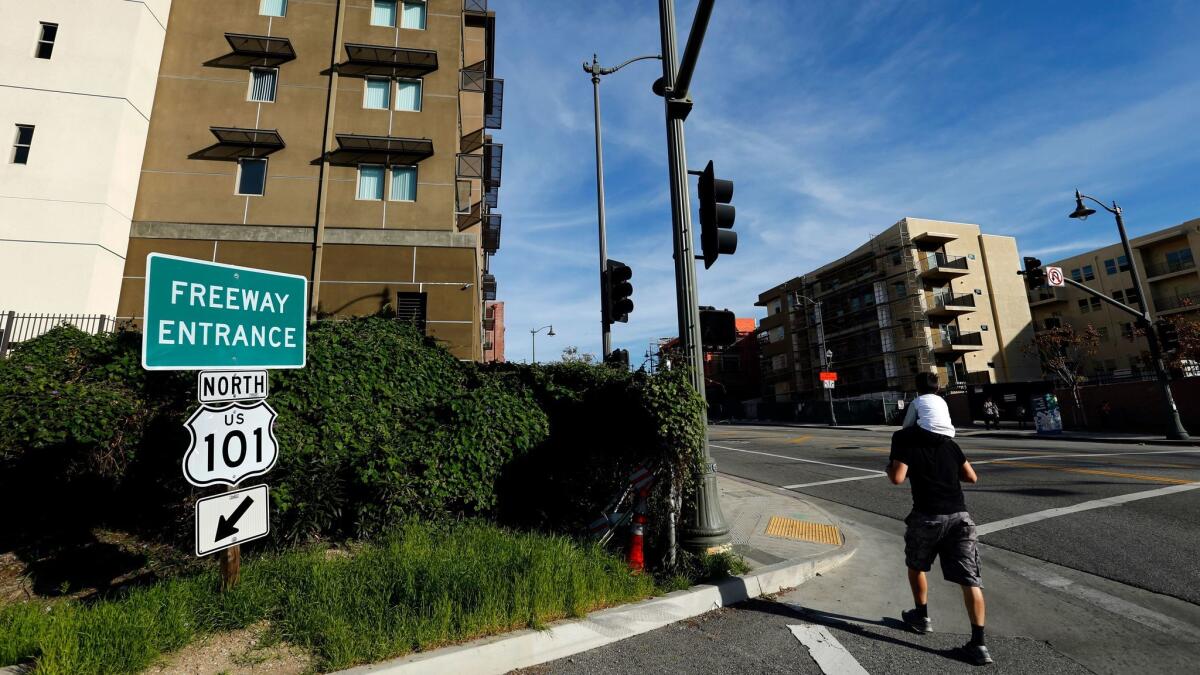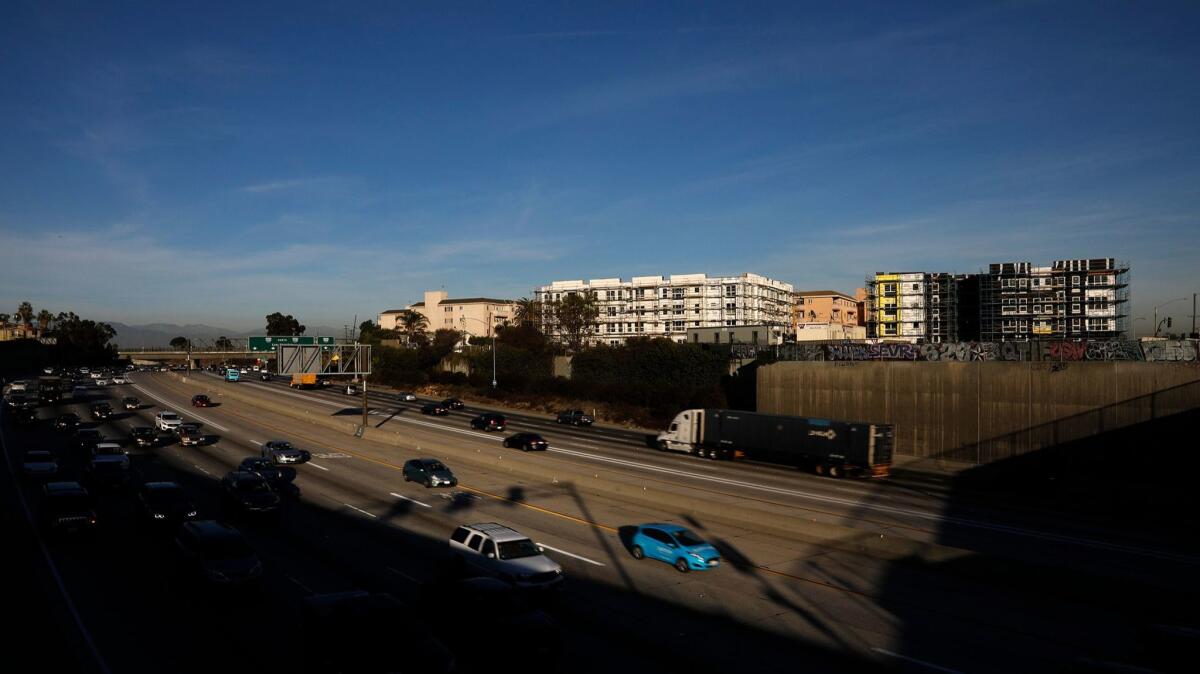Regulators warned against housing near freeways due to health risks. Now they’re warming to it

Earlier this year, the air board issued a new advisory that emphasizes design rather than distance, recommending anti-pollution features such as air filters, sound walls and thick vegetation as “promising strategies” to reduce the health risks from
- Share via
Twelve years ago, California air quality officials delivered a warning to cities and counties: Avoid putting new homes in high-pollution zones within 500 feet of freeways.
That advice, which relied on years of research linking traffic pollution to asthma, heart attacks and other health problems, was aimed at keeping “children and other vulnerable populations out of harm’s way,” according to the state Air Resources Board’s 2005 handbook.
But earlier this year, the air board shifted its stance. It issued a new advisory that emphasizes design rather than distance, recommending anti-pollution features such as air filters, sound walls and thick vegetation as “promising strategies” to reduce the health risks from freeways. With those measures, communities can build “while simultaneously reducing exposure to traffic-related pollution,” the air board said.
In making that change, air regulators acknowledged a stark reality: Despite health risks, cities desperate for more housing at a time of soaring rents keep approving homes near traffic pollution. The Times reported earlier this year that residential development along freeways has surged in the decade since the air board issued its warning.
Business leaders and housing advocates have cheered the pivot by the air board, contending limits on home building near freeways will worsen an affordability crisis. The new advisory has also been embraced by state planning officials, who say urban development near transit is essential to fighting climate change by reducing reliance on cars.
But some worry that amid a push to build homes, the air-quality agency has muddied what had been a clear, if controversial, health warning.
Scott Fruin, professor of preventive medicine at USC, said the air board’s latest document presents best-case scenarios and overstates the extent to which air filters and other anti-pollution measures protect residents. By recommending those steps, he said, state regulators “may give the false impression that it is now OK to put schools and residences close to freeways.”
“The best current strategy to reduce near-freeway exposure is not to put schools and residences there in the first place,” said Fruin, who previously worked at the Air Resources Board. “Even with the best reduction measures available, air pollution in these locations will remain unhealthy.”

Air board officials said they prepared the advisory to give policy-makers the latest, scientifically based options to reduce pollution exposure at a time when the state is encouraging home construction near transit lines that are often next to freeways and other high-traffic corridors.
Those projects are challenging in cities like Los Angeles, “where freeways and major thoroughfares abound,” air board spokesman Stanley Young said. “In responding to that reality we felt it was important to give planners and developers information on how to mitigate the impacts,” he added.
Kurt Karperos, a deputy executive officer for the air board, said the April advisory does not change the agency’s 2005 recommendation to avoid siting homes within 500 feet of freeways. “That’s a very basic health position that the agency has taken and we still stand by.”
In recent years, Karperos said, some have suggested the agency replace its recommendation for a 500-foot buffer, since vehicles have become less polluting over the last decade. “We disagreed.”
Still, one official in Gov. Jerry Brown’s administration reached a different conclusion, saying the 2005 recommendation “was replaced” by this year’s advisory on air filters, sound walls and other anti-pollution strategies.
Ken Alex, who directs the governor’s Office of Planning and Research, pointed to the April advisory as he defended the state’s decision to finance affordable housing next to freeways. The air board’s position is “much more nuanced than ‘don’t build’ ” within 500 feet, said Alex, whose agency is responsible for long-range policies on how California grows and develops.
State air regulators say their 2005 guidelines have not, in fact, been replaced.
Air Resources Board officials said they decided to supplement them in light of new science on freeway pollution and the effectiveness of air filters and other measures. Regulators drafted a report — an appendix to be considered in addition to the 2005 guidelines — and presented it to the air board in January 2016.
At that meeting, air board chair Mary Nichols acknowledged that the push for dense urban development, which can reduce driving and overall emissions, also can “result in increased exposures for people who live or go to school and spend any time outdoors in areas near roadways.”
“Trying to optimize both of these strategies has proven to be somewhat controversial and an interesting challenge,” Nichols said at the meeting.
The final document, published in April, was an advisory. Air quality officials do not have the power to regulate land use. The document said research shows “the public health, climate, financial, and other benefits of compact, infill development along transportation corridors” and found alternatives to distance-based guidelines “that can protect public health while not dictating development patterns.”
Among the suggestions in the report: Lower speed limits to 55 mph or less and install roundabouts to reduce vehicle emissions. Design city streets with parks, bike lanes, wider sidewalks and buildings with “varying shapes and heights” to disperse traffic pollutants.

The Air Resources Board’s influence has grown considerably over the last decade as its core mission — protecting people from pollution — has expanded to include efforts to slash greenhouse gas emissions. That shift has sparked criticism from some environmentalists, who contend that the board has made tackling health threats from local pollution secondary to the global fight against climate change.
The new focus on anti-pollution design puts the air board in closer alignment with the city of Los Angeles, which has adopted stronger filtration requirements but has not imposed limits on how close homes can be built to freeways. That emphasis also drew praise from housing advocates and developers, who viewed the 2005 guidelines skeptically.
Stuart Waldman, president of the Valley Industry and Commerce Association, said the air board’s latest advisory “just shows that the original policy was unrealistic to begin with.”
Alan Greenlee, executive director of the Southern California Assn. of Non-Profit Housing, said he is happy the state “seems to have moved in the direction of allowing building where previously they weren’t interested.” With filters and other anti-pollution measures, developers “can house people affordably and healthfully in areas where the government says there are air quality issues.”
Some environmentalists view things differently.
When the air board’s handbook came out in 2005, “we thought that was a real step forward,” said Bill Magavern, policy director for the Coalition for Clean Air.
Environmental groups have largely favored the state’s push to concentrate new homes near transit, citing the climate benefits. But without limits on homebuilding near freeway pollution, those policies will have unintended health consequences, Magavern said.
“New housing should be well planned so that it’s not putting residents’ health at risk,” Magavern said. “The goal is to have the homes near transit, not near freeways.”
In Southern California, officials with the South Coast Air Quality Management District say they continue to send letters to developers suggesting they increase the distance between new homes and traffic. In the Bay Area, air quality regulators last year published interactive traffic pollution maps and planning guidelines that recommend some of the same design measures as the state.
The Bay Area Air Quality Management District advised communities to put new homes as far from freeway pollution “as is feasible.” The words “as is feasible” were added “at the heavy insistence” of developers and affordable housing advocates, said Jackie Winkel, a principal environmental planner with the agency.
More to Read
Sign up for Essential California
The most important California stories and recommendations in your inbox every morning.
You may occasionally receive promotional content from the Los Angeles Times.












